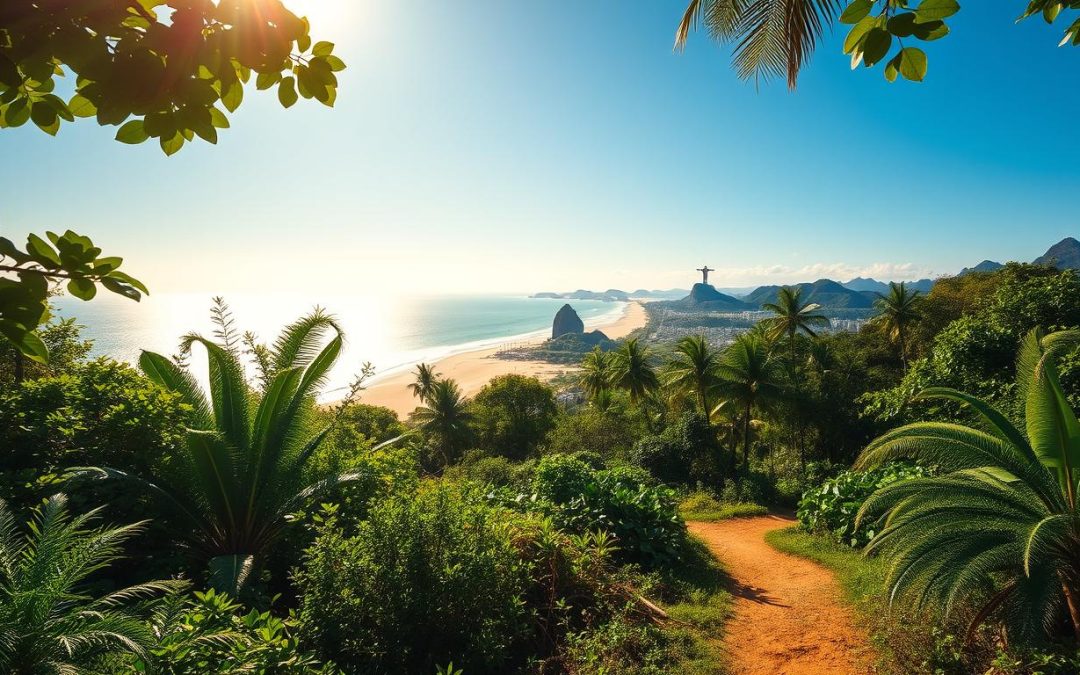Have you ever wondered when the perfect time is to explore a destination with ideal weather and fewer crowds? Planning your journey around the right season can make all the difference in your travel experience. This guide will help you uncover the best months to visit, ensuring you enjoy pleasant conditions and vibrant cultural events.
Choosing the right time to travel isn’t just about avoiding rain or heat. It’s about aligning your trip with the region’s unique climate patterns and festivities. Whether you’re drawn to sunny beaches, lush rainforests, or bustling cities, understanding the weather trends can elevate your adventure.
From temperature insights to festival highlights, this article provides all the details you need to plan a seamless getaway. Let’s dive into what makes certain months stand out for an unforgettable experience.
Key Takeaways
- Discover the ideal months for pleasant weather and fewer tourists.
- Learn about regional climate variations and their impact on your trip.
- Explore major festivals and events that enhance your travel experience.
- Understand temperature and rainfall trends for better planning.
- Get tips on travel safety and making the most of your visit.
Understanding Brazil’s Climate and Seasonal Patterns
Understanding the climate of a destination can transform your travel experience. This vast country offers a wide range of weather patterns, from tropical rainforests to cooler southern regions. Knowing these variations helps you choose the right time to visit and make the most of your trip.
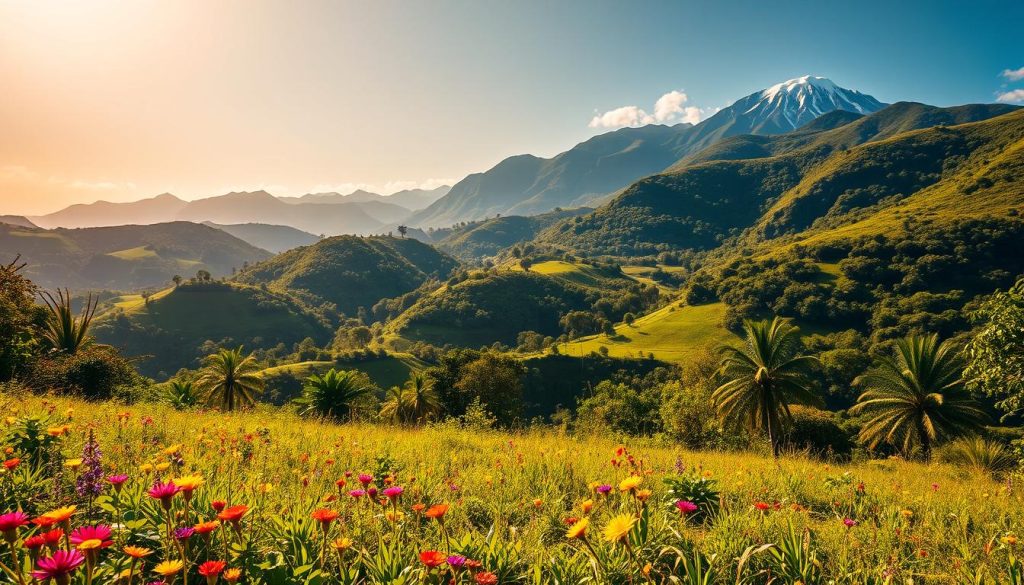
Regional Weather Variations
Brazil’s weather varies significantly across its regions. The Amazon Basin, for example, experiences a tropical climate with high humidity and frequent rain. In contrast, the southern coastal areas enjoy milder temperatures and distinct seasons. Here’s a quick breakdown:
- Amazon Region: Hot and humid year-round, with heavy rainfall from December to May.
- Southern Coast: Cooler winters (June-August) and warm summers (December-February).
- Northeast: Warm and sunny, with a dry season lasting most of the year.
Seasonal Temperature Trends
Seasonal changes play a big role in shaping your travel plans. In the south, temperatures can drop to 60°F (16°C) in July, while the north stays warm at around 86°F (30°C). Here’s what to expect:
- Summer (December-February): Hot and humid, especially in the north.
- Winter (June-August): Cooler and drier, ideal for exploring southern cities.
- Transition Months: March-May and September-November offer milder weather and fewer crowds.
By aligning your trip with these patterns, you can enjoy pleasant conditions and avoid extreme weather.
Weather Highlights for Brazil’s Top Cities
Exploring Brazil’s top cities means diving into diverse weather patterns. Each destination offers a unique climate experience, making it essential to understand what to expect. Whether you’re drawn to tropical beaches or urban landscapes, knowing the weather can enhance your trip.
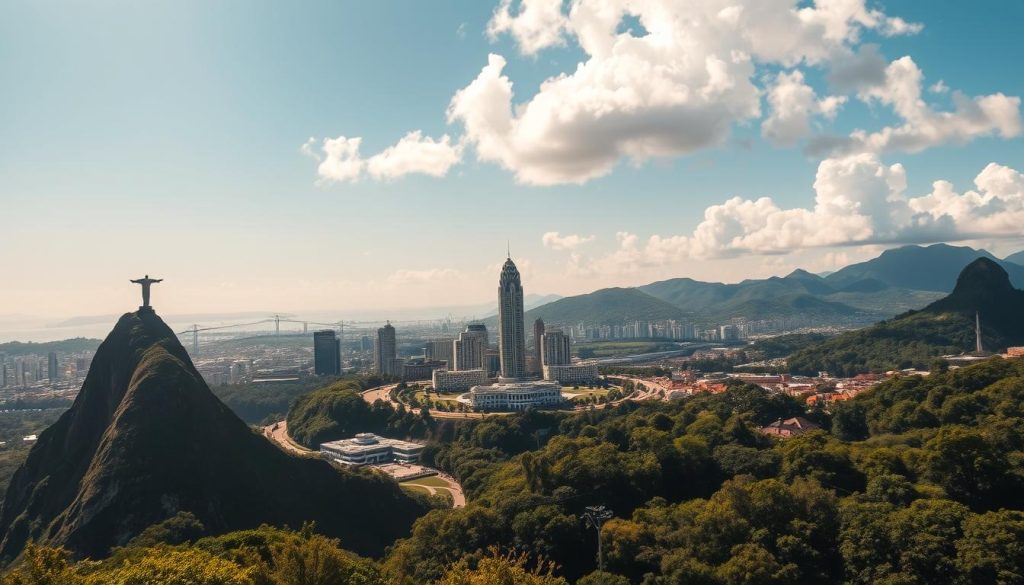
City Weather Comparison
Brazil’s vast size leads to significant temperature variations across its cities. For example, Rio de Janeiro enjoys warm weather year-round, while São Paulo experiences milder conditions. Here’s a quick look at average temperatures in key destinations:
| City | Average High (°F) | Average Low (°F) |
|---|---|---|
| Rio de Janeiro | 86 | 72 |
| São Paulo | 77 | 59 |
| Salvador | 84 | 73 |
| Porto Alegre | 75 | 57 |
Rio de Janeiro is known for its consistent warmth, perfect for beach days. In contrast, São Paulo’s cooler evenings make it ideal for exploring its vibrant nightlife. Salvador’s tropical climate is great for outdoor activities, while Porto Alegre offers a more temperate experience.
Choosing the right time visit is essential. For instance, visiting Rio de Janeiro during its dry season (May-October) ensures sunny skies. Meanwhile, São Paulo’s mild winters (June-August) are perfect for sightseeing without the summer crowds.
Understanding these differences helps you plan better. Whether you’re chasing the sun or prefer cooler weather, Brazil’s diverse settings are a traveler’s dream.
June in Brazil: Festivals, Family Holidays, and Outdoor Fun
June brings a unique blend of cultural vibrancy and pleasant weather to explore. This month is a favorite for travelers seeking mild temperatures and lively celebrations. Whether you’re drawn to traditional festivals or outdoor adventures, June offers something for everyone.
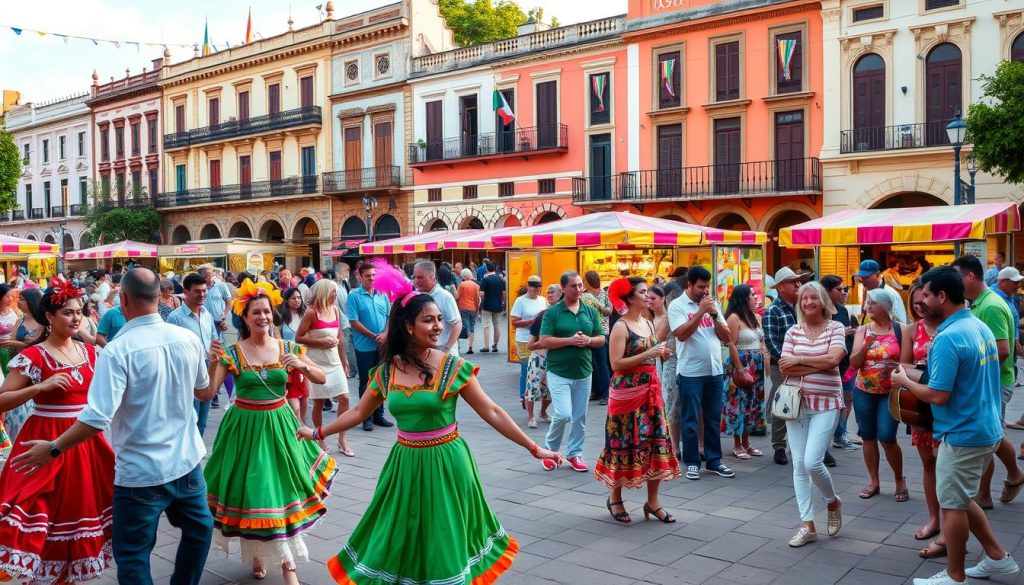
Cultural Celebrations and Unique Events
June is packed with cultural events that showcase the country’s rich traditions. One of the most popular is Festa Junina, a vibrant celebration featuring folk dances, traditional foods, and colorful decorations. This event is especially lively in cities like São Paulo and Recife.
Another highlight is Corpus Christi, a religious holiday marked by intricate street carpets made of flowers and sawdust. In cities like Ouro Preto, these displays are a sight to behold. Additionally, Saint Anthony’s Day honors the patron saint of marriage with festive gatherings and local customs.
These celebrations are not just about fun—they offer a deep dive into the country’s cultural heritage. Participating in these events lets you connect with locals and experience traditions firsthand.
Weather and Outdoor Activities
June’s weather is ideal for exploring. In the southeast, dry conditions make it perfect for outdoor adventures like hiking and sightseeing. Cities like Rio de Janeiro and Belo Horizonte enjoy sunny days with average highs of 82°F (28°C).
On the northeastern coast, rainier weather adds a refreshing touch to the tropical climate. This makes it a great time to visit destinations like Salvador, where you can enjoy both cultural events and beach activities.
Whether you’re strolling through festival grounds or exploring natural wonders, June’s climate enhances every experience. It’s a month that combines the best of culture and nature, making it a must-visit time for travelers.
Brazil: Best Months for a Weather-Savvy Trip
Planning your travel dates wisely can make your trip more enjoyable and cost-effective. By choosing the right month, you can avoid extreme weather, save money, and enjoy fewer crowds. Let’s explore how to identify the ideal date for your adventure.
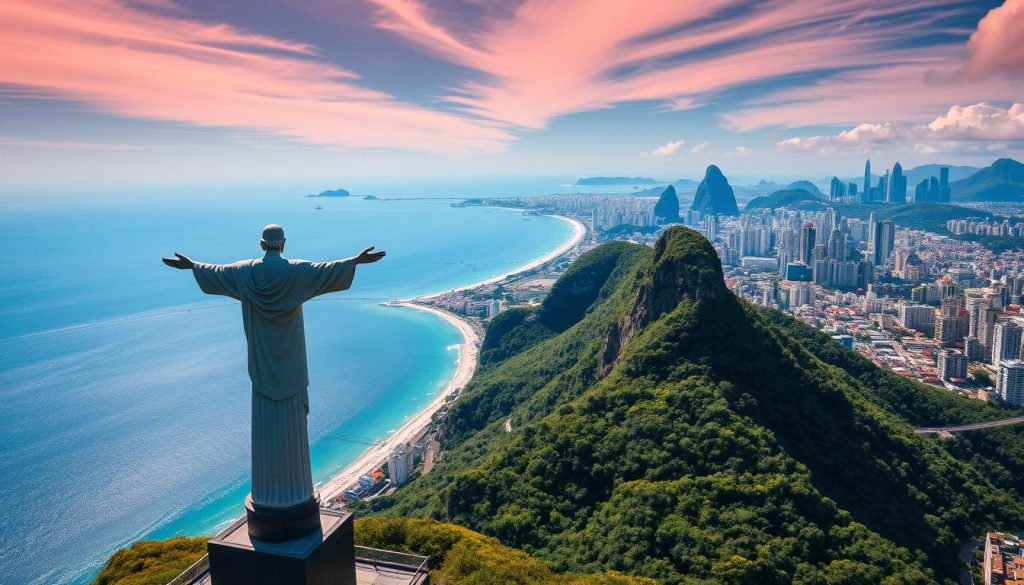
Identifying Ideal Travel Dates
To find the best time visit, consider both weather and pricing. For example, traveling during shoulder seasons like March-May or September-November often offers a perfect balance. These periods typically have milder weather and lower prices compared to peak tourist months.
Here’s a quick comparison of different months:
- December-February: Peak season with warm weather but higher costs and crowds.
- June-August: Cooler temperatures and fewer tourists, ideal for exploring cities.
- March-May: Transition months with pleasant weather and affordable rates.
By aligning your trip with these insights, you can enjoy a more comfortable and budget-friendly experience. For instance, visiting in June allows you to experience cultural festivals without the summer rush.
Understanding these patterns helps you plan better. Whether you’re chasing sunny skies or prefer cooler weather, choosing the right month ensures a memorable journey.
Planning Your Trip: Packing Tips and Practical Advice
Packing smartly can make or break your travel experience, especially in a country with diverse climates. From tropical heat to cooler southern regions, being prepared ensures you’re ready for anything. Here’s how to pack efficiently and stay safe while exploring.
Essential Clothing and Gear
Your packing list should adapt to the weather you’ll encounter. For summer destinations, lightweight and breathable fabrics are a must. Think cotton shirts, shorts, and sandals. Don’t forget a wide-brimmed hat and high SPF sunscreen to protect against strong sun exposure.
If you’re heading to cooler areas during winter, pack layers like sweaters, jackets, and long pants. A compact raincoat or umbrella is essential for sudden showers, especially in tropical regions. For outdoor adventures, sturdy hiking boots and moisture-wicking socks are key.
Here’s a quick checklist for versatile packing:
- Clothing: 5 tops, 4 bottoms, 2 dresses, 1 pajama set.
- Shoes: 2 comfortable walking shoes, 1 dressier pair.
- Accessories: Hat, sunglasses, scarf, and a reusable water bottle.
- Rain Gear: Lightweight raincoat or travel umbrella.
Travel Safety and Local Insights
Staying safe while traveling is just as important as packing the right gear. Always carry a small first aid kit with essentials like pain relievers, bandages, and insect repellent. In tropical areas, use repellent with DEET or picaridin to protect against insect-borne diseases.
Keep your valuables secure by using a money belt or anti-theft bag. It’s also wise to carry a mix of local currency and major credit cards, as ATMs may not be accessible in remote areas. A portable charger and voltage converter are handy for keeping your devices powered.
Here are some additional tips to enhance your experience:
- Stay Hydrated: Carry a reusable water bottle to avoid buying bottled water.
- Be Weather-Ready: Check forecasts daily and adjust your plans accordingly.
- Local Etiquette: Learn a few basic phrases in the local language to connect with residents.
By packing wisely and staying informed, you’ll be ready to enjoy every moment of your adventure. Whether you’re exploring bustling cities or serene landscapes, preparation is the key to a smooth and memorable trip.
Peak vs Off-Peak: Analyzing Tourist Crowds and Pricing
Deciding when to travel can significantly impact your experience, especially when balancing crowds and costs. Traveling during peak seasons often means higher prices and busier attractions, while off-peak periods offer quieter destinations and better deals. Understanding these dynamics helps you plan a trip that fits your budget and preferences.
Advantages and Disadvantages of Peak and Off-Peak Travel
Traveling during peak times, like December to March, has its perks. You’ll experience vibrant festivals and ideal weather, but expect higher prices and larger crowds. For example, airfare can increase by 30%-50% during these months. On the other hand, off-peak travel, such as March-May or September-November, offers lower costs and fewer tourists. However, you might encounter unpredictable weather or limited event options.
Here’s a quick comparison of the two periods:
| Period | Advantages | Disadvantages |
|---|---|---|
| Peak (Dec-Mar) | Ideal weather, major events | Higher prices, crowded attractions |
| Off-Peak (Mar-May, Sep-Nov) | Lower costs, fewer tourists | Unpredictable weather, limited events |
Budget Considerations for Families and Solo Travelers
Planning your trip during off-peak periods can save you money, especially if you’re traveling with family. For instance, booking flights in early spring or late fall can result in savings of up to 30%. Solo travelers can also benefit from midweek departures, which are often 20% cheaper than weekend flights.
Here are some tips to maximize your budget:
- Use price alert systems to monitor fare fluctuations.
- Be flexible with travel dates to secure lower fares.
- Consider shoulder seasons for a balance of good weather and affordability.
By understanding the trade-offs between peak and off-peak travel, you can make informed decisions that enhance your experience. Whether you’re seeking vibrant festivals or peaceful escapes, choosing the right period ensures a memorable and cost-effective journey.
Month-by-Month Guide to Brazil’s Weather and Events
Each month offers unique weather and cultural highlights to explore. Whether you’re chasing sunny skies or vibrant festivals, understanding the seasonal changes can help you plan the perfect trip. Here’s a detailed breakdown of what to expect throughout the year.
Seasonal Overview
Brazil’s weather varies significantly by region and time of year. In the Amazon, the rainy season from December to May brings lush landscapes but frequent showers. Meanwhile, the southern coast enjoys milder temperatures, especially from June to August.
Here’s a quick look at the key seasons:
- December-February: Warm and humid, ideal for beach destinations.
- March-May: Transition months with fewer crowds and pleasant weather.
- June-August: Cooler and drier, perfect for exploring cities.
- September-November: Mild temperatures and vibrant festivals.
Special Events Calendar
Every month brings its own set of events and celebrations. From world-famous carnivals to local festivals, there’s always something happening. Here’s a snapshot of the most notable events:
- January: New Year’s celebrations and lively beach parties.
- February/March: Carnival, the biggest festival of the year, fills the streets with music and dance.
- April: Holy Week processions and cultural performances.
- June: Festa Junina celebrates rural traditions with folk dances and traditional foods.
- September: Independence Day parades and patriotic celebrations.
- December: Christmas markets and festive lights brighten cities.
By aligning your travel plans with these events, you can immerse yourself in the local culture and create unforgettable memories. Whether you’re visiting in January or December, there’s always something special to experience.
Conclusion
Timing your trip well can transform your experience into something truly unforgettable. By understanding the weather patterns and seasonal events, you can plan a journey that aligns with your preferences. Whether you’re drawn to sunny beaches or vibrant festivals, choosing the right month makes all the difference.
For example, visiting Rio de Janeiro during the New Year celebrations offers a unique blend of fireworks, beach parties, and cultural vibrancy. Meanwhile, traveling in March or April provides milder weather and fewer crowds, making it ideal for exploring cities like São Paulo or Salvador.
| City | Best Time | Highlights |
|---|---|---|
| Rio de Janeiro | December-February | New Year celebrations, sunny beaches |
| São Paulo | March-May | Mild weather, fewer crowds |
| Salvador | June-August | Cultural festivals, pleasant temperatures |
Understanding these insights helps you make informed decisions. Whether you’re planning a family vacation or a solo adventure, aligning your trip with the right time visit ensures a memorable and crowd-conscious experience.
Use this guide to plan your journey and create unforgettable memories. From the lively streets of Rio to the serene landscapes of the countryside, every day of your trip can be filled with joy and discovery.
Additional Resources and Final Tips
To make the most of your journey, it’s essential to have the right resources and insights at your fingertips. Whether you’re planning a beach getaway or exploring vibrant festivals, these tips will help you stay prepared and confident.
Start by checking reliable travel guides and FAQs for up-to-date information. Packing checklists and safety tips from trusted sources can ensure you’re ready for any season. For example, if you’re traveling during the rainy period, bring a lightweight raincoat and waterproof gear.
When visiting tourist hotspots, respect local culture by learning basic phrases and customs. This not only enhances your experience but also fosters meaningful connections with locals. For budget-friendly options, consider traveling during shoulder seasons like March or September, when prices are lower and crowds are thinner.
Finally, stay flexible with your plans. Weather can change quickly, so adjust your itinerary as needed. With these resources and tips, you’re all set for an unforgettable adventure.
The above is subject to change.
Check back often to TRAVEL.COM for the latest travel tips and deals.
Here are some Tours & Sightseeing suggestions that might pique your interests!
